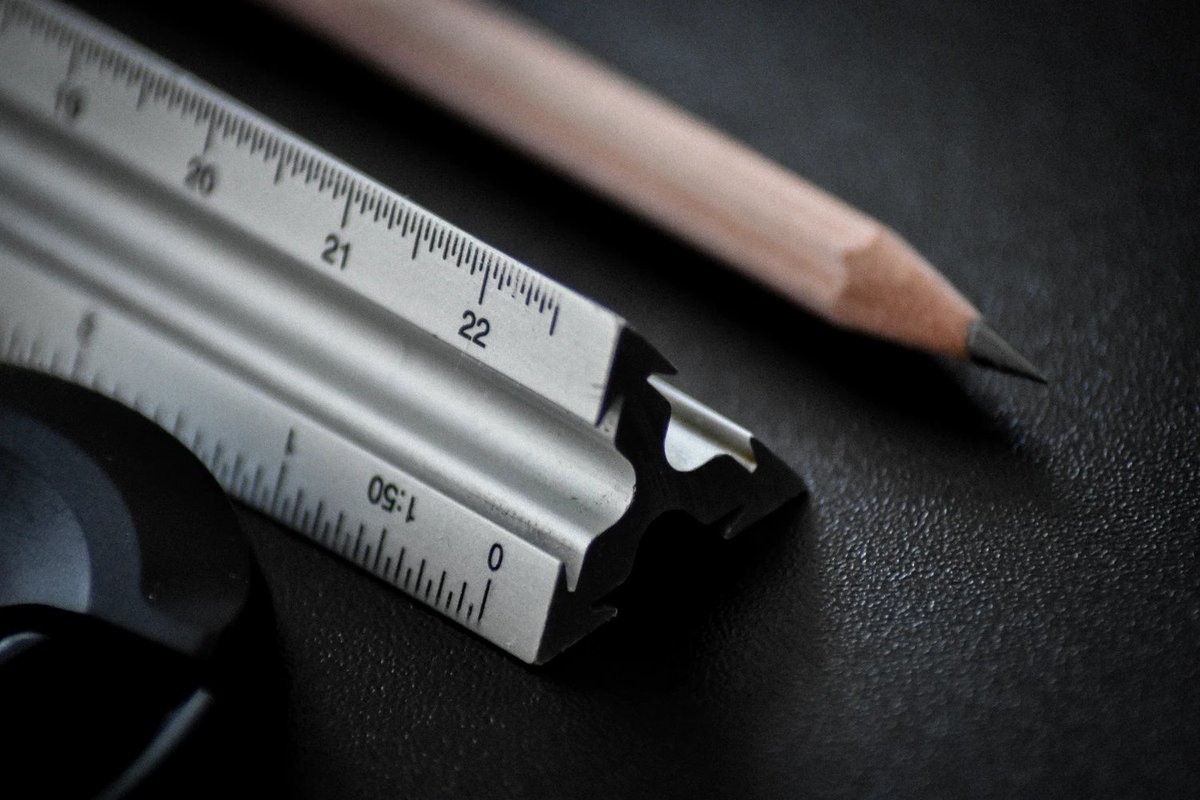
Do you use Metric or Imperial measurements?
This week, after a lifetime of unwavering loyalty to Metric, I dug in - & now my mind’s blown. Now I get why folk cling to Imperial.
(And also why Napoleon was taller than he’s given credit for.)
Get comfy. It’s a long one.
(1/)
This week, after a lifetime of unwavering loyalty to Metric, I dug in - & now my mind’s blown. Now I get why folk cling to Imperial.
(And also why Napoleon was taller than he’s given credit for.)
Get comfy. It’s a long one.
(1/)

First, let’s call Metric what it was: a sensible act of revolutionary rationalism.
Europe before the French Revolution was a pig's ear of measurement systems: at least 250,000 (!) in France alone. Every region of every country used something a bit different.
Carnage.
(2/)
Europe before the French Revolution was a pig's ear of measurement systems: at least 250,000 (!) in France alone. Every region of every country used something a bit different.
Carnage.
(2/)

This new system, first proposed in 1790, would rely on unchanging laws of Nature, the kind that everyone could agree upon.
Good plan, right?
Yes and no. First they had to measure Nature with late 18thC technology - and that proved *maddeningly* hard.
(3/)
Good plan, right?
Yes and no. First they had to measure Nature with late 18thC technology - and that proved *maddeningly* hard.
(3/)

(By the way, all this is going into my next newsletter, hence why I’ve been researching it. If you like maps, science, curiosity, and reading stuff that makes your brain go !!!??!!$%, please click below & sign up:
everythingisamazing.substack.com/about
OK! On we go.)
(4/)
everythingisamazing.substack.com/about
OK! On we go.)
(4/)
Measuring a metre in the 1790s was no small undertaking.
Back then, it was defined as one-ten-millionth of the distance from the North Pole to the Equator*.
And someone had to go out and measure exactly how long that was.
Yeah.
*It’s now based on the speed of light.
(5/)
Back then, it was defined as one-ten-millionth of the distance from the North Pole to the Equator*.
And someone had to go out and measure exactly how long that was.
Yeah.
*It’s now based on the speed of light.
(5/)

Two astronomers were dispatched into Europe: one to Dunkirk, one to Barcelona. Their mission: to climb extremely tall things, take measurements and extrapolate a curve.
They thought it would take a year. It took 7 - and became a true adventure.
*Not* an exaggeration:
(6/)
They thought it would take a year. It took 7 - and became a true adventure.
*Not* an exaggeration:
(6/)
“Along the way [they] would be imprisoned, injured, almost executed, scorched, frozen, mistaken for sorcerers & spies, fired, reinstated, vilified, celebrated and then vilified again. For Méchain, the task...would lead eventually to his death.”
Science as high drama: tick.
(7/)
Science as high drama: tick.
(7/)

That's from the Guardian’s review of Ken Alder’s ‘The Measure Of All Things’, written using the recently-discovered notebooks of both astronomer-adventurers:
theguardian.com/books/2002/oct…
All that, "just" to decide the length of the metre. (Imagine what else went on.)
(8/)
theguardian.com/books/2002/oct…
All that, "just" to decide the length of the metre. (Imagine what else went on.)
(8/)
By 1799, Metric's ready to roll out.
Think about what this means, though. A new system of measurement partly based on things too big for folk to actually *see*.
Imagine you’re an Andy Weir character, explaining a metre to an alien. How? What’s your frame of reference?
(9/)
Think about what this means, though. A new system of measurement partly based on things too big for folk to actually *see*.
Imagine you’re an Andy Weir character, explaining a metre to an alien. How? What’s your frame of reference?
(9/)

(10/)
Okay, a quick poll on how you measure stuff in your head.
Do you:
Okay, a quick poll on how you measure stuff in your head.
Do you:
Right now, around 5% of the world’s population uses Imperial.
That’s Myanmar, Liberia, and (most famously of all) the United States.
(Except...Britain does too. A bit. Quietly. We often think in miles, pounds, inches & so on. *Unofficially*, mind. Shhhhhh.)
(11/)
That’s Myanmar, Liberia, and (most famously of all) the United States.
(Except...Britain does too. A bit. Quietly. We often think in miles, pounds, inches & so on. *Unofficially*, mind. Shhhhhh.)
(11/)

You know who also liked to think in Imperial? The French, c. 1799 (when Metric launched).
It didn't help that Paris ran out of rulers (the wooden kind). Vital for teaching how long the new-fangled metre was.
So the govt threw money at anyone mass-producing wooden rulers.
(12/)
It didn't help that Paris ran out of rulers (the wooden kind). Vital for teaching how long the new-fangled metre was.
So the govt threw money at anyone mass-producing wooden rulers.
(12/)

Nevertheless, The French population remained stubbornly non-Metric. And it's well worth thinking about why.
(It's not just natural human resistance to change - although that too, obviously.)
(13/)
(It's not just natural human resistance to change - although that too, obviously.)
(13/)

(Quick caveat: there's a tendency to call everything non-Metric "Imperial". So there are MANY Imperials. Beware.)
OK, Imperial.
A foot is...your foot.
An inch is the top half of your thumb - or what you do with your fingers when someone says "what's an inch?" 😄
(14/)
OK, Imperial.
A foot is...your foot.
An inch is the top half of your thumb - or what you do with your fingers when someone says "what's an inch?" 😄
(14/)

"Mile" comes from the Latin for "thousand" - and was originally defined as a thousand paces. Nice & simple.
Since there are 5,280 feet in a mile, those would be bloody huge paces - except, there are many different types of Mile: Roman, Arabic, Scots, nautical...
Sigh.
(15/)
Since there are 5,280 feet in a mile, those would be bloody huge paces - except, there are many different types of Mile: Roman, Arabic, Scots, nautical...
Sigh.
(15/)

But on the whole, pre-Metric measurements were made from observation. Imprecise, woolly - but deeply practical.
Like the ancient Cubit: the length from elbow to middle finger. Still used by people who lay hedges, funnily enough: bit.ly/hedgecubits
What about Metric?
(16/)
Like the ancient Cubit: the length from elbow to middle finger. Still used by people who lay hedges, funnily enough: bit.ly/hedgecubits
What about Metric?
(16/)

To generalise wildly, Metric has come from the Romans, and the Greeks before them - and our hands before that.
Because we count with our fingers.
But look elsewhere in Nature for the number Ten, and you'll struggle. (It's not a Fibonacci number: science.howstuffworks.com/math-concepts/…)
(17/)
Because we count with our fingers.
But look elsewhere in Nature for the number Ten, and you'll struggle. (It's not a Fibonacci number: science.howstuffworks.com/math-concepts/…)
(17/)
So, by 1812, most of France was saying "HELL NON" to Metric - and Napoleon was fed up with the whole thing.
He launched a compromise, just for trading purposes, called the Customary Measures.
1 toise (exactly 2 metres) = 6 pieds (feet) = 72 pouces (inches)...
(18/)
He launched a compromise, just for trading purposes, called the Customary Measures.
1 toise (exactly 2 metres) = 6 pieds (feet) = 72 pouces (inches)...
(18/)

Except, hold on. These were FRENCH Inches. Not British (or elsewhere) Inches. Not "Imperial" inches.
(Just the kind of nightmare that Metric tried to fix.)
Napoleon, famously, was 5 feet 2 inches tall.
But in Imperial, that's *5 foot 7*:
history.com/news/napoleon-…
(19/)
(Just the kind of nightmare that Metric tried to fix.)
Napoleon, famously, was 5 feet 2 inches tall.
But in Imperial, that's *5 foot 7*:
history.com/news/napoleon-…
(19/)
There are plenty of gentlemen in the world these days who are 5 foot 7, and I'm not going to comment on whether they're considered "short" or not. I'm leaving that one well alone.
But in France in the early 19thC, this was average height.
So Napoleon was average height.
(20/)
But in France in the early 19thC, this was average height.
So Napoleon was average height.
(20/)

France's Customary Measures lasted until 1840, when Metric was reinstated. But it arguably took the country another half-century to firmly embrace the system. It took a while to learn.
Once you learned it, though, wow. Calculating stuff was so easy it was like MAGIC.
(21/)
Once you learned it, though, wow. Calculating stuff was so easy it was like MAGIC.
(21/)
For universally agreed-upon precision, Metric is generally unassailable.
But for observational truth, a lot of Imperial still makes terrific sense - to the degree* that I think we still need it, & many other "lost measurements" of history along the way.
(22/)
*take your pick.
But for observational truth, a lot of Imperial still makes terrific sense - to the degree* that I think we still need it, & many other "lost measurements" of history along the way.
(22/)
*take your pick.

I'm going to talk more about all this in an upcoming newsletter here: everythingisamazing.substack.com/about Sign up if you want to get it when it's ready.
But a final interesting angle on all this:
Hey, what's your favourite number?
(23/)
But a final interesting angle on all this:
Hey, what's your favourite number?
(23/)

For his 2015 book "The Grapes Of Math", Alex Bellos ran an online survey of 30,000 people, asking everyone's favourite numbers:
scientificamerican.com/article/most-p…
At nearly 10% of the vote - the number 7.
(24/)
scientificamerican.com/article/most-p…
At nearly 10% of the vote - the number 7.
(24/)
In second place, the number 3 - which tallies with everything I've learned about the strange power of the Rule Of Three:
en.wikipedia.org/wiki/Rule_of_t…
And 10? Twenty-third place, with just over 1% of the vote.
(25/)
en.wikipedia.org/wiki/Rule_of_t…
And 10? Twenty-third place, with just over 1% of the vote.
(25/)
The reasons that we form emotional attachments to numbers are....a lifetime of unravelling.
But look how low-down 10 is in that list? (What's the % of metric-first people who answered the survey?)
Anyway. Fascinating topic. I could go on! (I won't. Have stuff to write.)
(26/)
But look how low-down 10 is in that list? (What's the % of metric-first people who answered the survey?)
Anyway. Fascinating topic. I could go on! (I won't. Have stuff to write.)
(26/)
Correction!
https://twitter.com/c_dan4th/status/1422937895069904901:)
And as usual, I got most of these images via Unsplash - for example, this gorgeous one from Jan Antonin Kolar: unsplash.com/photos/uYmF6nc…
(27/)
(27/)

And thank you to everyone discussing/fighting in the subthreads, eg:
Your lack of agreement on these things gives me hope for a measurement-diverse future.
(Image via statista.com/chart/18300/co…)
(Fin.)
https://twitter.com/douglasmack/status/1422908636653887496
Your lack of agreement on these things gives me hope for a measurement-diverse future.
(Image via statista.com/chart/18300/co…)
(Fin.)

Correction to this: the article says Napoleon was over 5 foot 5; I've seen 5 ft 6 & 5 ft 7 cited elsewhere.
Please consider him "somewhere between 5ft5 & 5ft7" but most importantly "not 5ft2". So he might have indeed been...less tall than Tom Cruise. (Sorry, Tom.)
Please consider him "somewhere between 5ft5 & 5ft7" but most importantly "not 5ft2". So he might have indeed been...less tall than Tom Cruise. (Sorry, Tom.)
• • •
Missing some Tweet in this thread? You can try to
force a refresh











